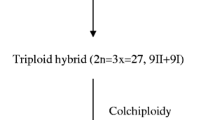Abstract.
The flavonoid chemistry of 16 species of Chenopodium was investigated, with an emphasis on C. album and its relatives. The chief compounds seen were 3-O-glycosides of quercetin, kaempferol and isorhamnetin. The latter two classes show a mutually exclusive distribution among the diploid and all but one tetraploid species. C. polyspermum is unusual in possessing O-methylation at the 4′-, 6- and 7-positions, and C. murale is the only taxon to have 7-O-glycosylation. Acylated glycosides are common. C. album and related hexaploid taxa display a single flavonoid profile, providing no support for the recognition of more than one species. The hexaploid flavonoid profile represents an almost perfect summation of those of the diploids, C. suecicum and C. ficifolium. This apparent additive inheritance supports the hypothesis that these species (or taxa very similar to them) are involved in the ancestry of C. album. Chromosome numbers are reported for 14 of the species.
Similar content being viewed by others
Author information
Authors and Affiliations
Corresponding author
Rights and permissions
About this article
Cite this article
Rahiminejad, M., Gornall, R. Flavonoid evidence for allopolyploidy in the Chenopodium album aggregate (Amaranthaceae). Plant Syst. Evol. 246, 77–87 (2004). https://doi.org/10.1007/s00606-003-0108-9
Received:
Published:
Issue Date:
DOI: https://doi.org/10.1007/s00606-003-0108-9




